#Modern Interior Rug Ideas
Text








Visit my website for more inspiration 🌿
#green velvet sofa#plants#greenery#interior design#home decor#home ideas#homedecor#homedesign#home design#indoor plants#brick wall#velvet#mid century modern#love#beautiful#throw pillows#persian rugs#vintage#naturecore#wall art#painting#flower aesthetic#sofa
13 notes
·
View notes
Photo

Denver Bedroom
#Ideas for a mid-sized#modern#carpeted master bedroom remodel without a fireplace contemporary bedroom design#bedroom interior design#decorative area rug#dark hardwood bedroom floors#bedroom remodeling
1 note
·
View note
Photo

Bedroom - Contemporary Bedroom
#Ideas for a mid-sized#modern#carpeted master bedroom remodel without a fireplace contemporary bedroom design#bedroom custom window treatments#decorative area rug#bedside table lamps with white shade#bedroom interior design#bedroom remodeling#bedroom renovation
0 notes
Photo

Master Bedroom (Denver)
#Ideas for a mid-sized#modern#carpeted master bedroom remodel without a fireplace recessed bedroom lighting#dark hardwood bedroom floors#bedroom interior design#bedside table lamps with white shade#decorative area rug#bedroom custom window treatments
0 notes
Photo
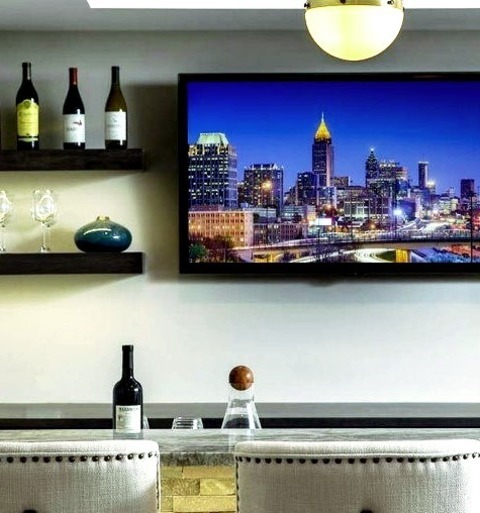
Atlanta Contemporary Home Bar
#Mid-sized modern l-shaped wet bar idea with a dark wood floor white home bar ceiling#custom home bar cabinets#unique home bar#custom home bar furniture#home bar interior design#decorative home bar area rug#beige home bar walls
1 note
·
View note
Note
I have some thoughts about the mood board to share later (currently ass deep in research, it's fine), but what kind of personal touches does each of the boys' (plus Ren's) rooms have? And how much does each room depart from the base interior of the hold?
The boys have pretty much free lease on their own spaces, but most of them largely go with the same baroque style, just... in different colors.
I'm just slapping down ideas with Google Image search. Long post is long and also image heavy.
Killer's room looks like:
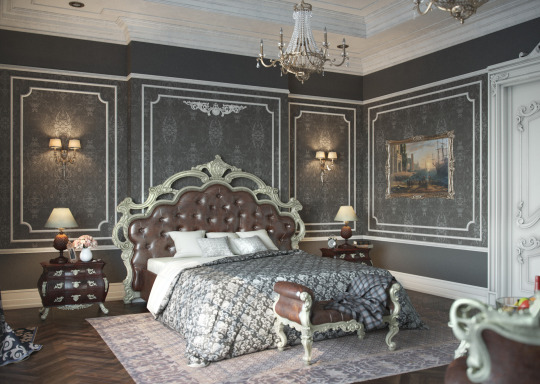
This, but with darker greys and some touches of red. His bed is pushed up against one wall as well, but he does have a lot of the same furniture. His room is fairly simple by choice, featuring little more than a desk, some bookshelves, a dresser, a standing mirror, and a single chair and coffee table. It's all fairly worn as well, but he's managed to not destroy the original fixtures. His room is on the inner side of the hallway, so he doesn't have a balcony or windows. He doesn't mind.
Dust's room looks like:

This in muted greys and dark blues (and minus the chandelier). He has a balcony and windows, a lot of bookshelves, two desks, a seating area near a fireplace (that frequently isn't lit) a wardrobe, and a lot of rugs. His furniture is both very heavy and fairly modern-- he's destroyed enough of it in LV attacks that he learned heavy furniture will deter him from ruining it, and even if he does, it's easier to replace than the nice-ass stuff elsewhere in the castle.
Axe's room looks like:

But, similar to Dust, he has it in muted greys and blues. He also doesn't have such a fancy headboard or curtain-- actually, he doesn't have a lot at all that's very fancy. Like Killer, his room is on the inside wall of the hallway, so he has no window or balcony. He has some threadbare rugs, with a few, newer and softer ones closer to his bed and the bathroom. He has an enormous bed that takes up most of the space, but also has a large comfy sofa in a small seating area, a wide dresser, a desk he doesn't often use, and some bookshelves. These are a mix of modern and fancy-- the desk is very fancy, but a California King doesn't really have a lot of options in fancier styles. It and the dresser are both very modern.
Cross' room looks like:
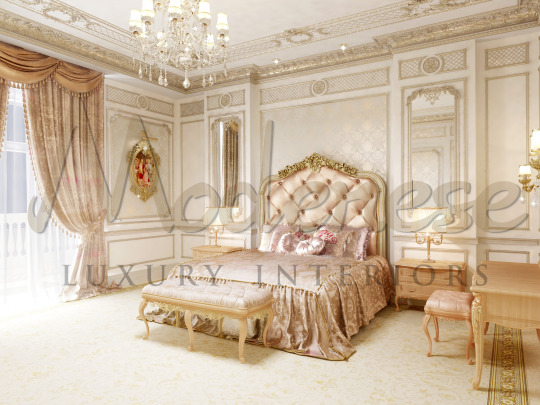
... except with less gold and more black. He's more-or-less left it as-is, but has a balcony and windows. He has the seating area, fireplace, desk, bookshelves, wardrobe, and standing mirror. His desk is piled high with masses of paperwork, since he does the bulk of the mission write-ups. Everything else in his room looks... barely used. It's clear he's only usually in it to write reports and sleep.
Baggs' room looks like:
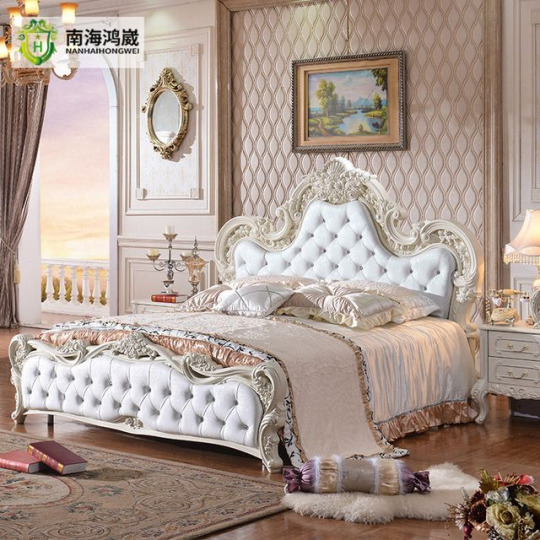
Lots of white with touches of champagne and gold. He hasn't done a lot to it, because he's rarely there. Mostly it was a color shift from black to white (since he's used to white, being in the lab as often as he is). Like the other balconied rooms, he has a fireplace and a seating area. He has two desks, a wardrobe, standing mirror, and a chaise (also in the seating area). It's entirely dependent on where he is when Nightmare knocks him out if he sleeps in this room, or sleeps in a side room in the lab.
Nightmare's room looks like:

and
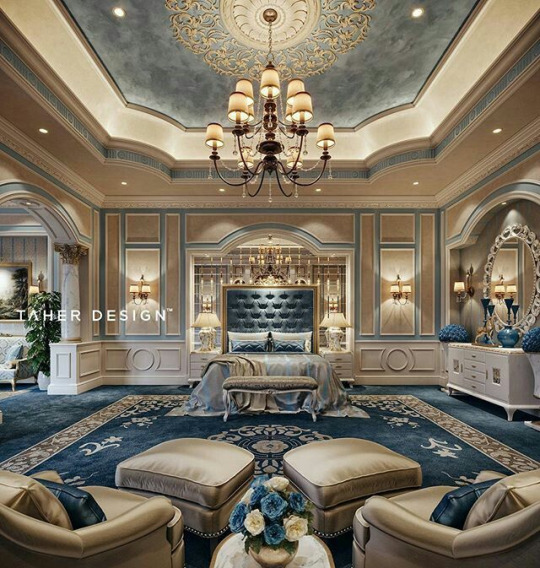
in black and gold. The bed is enormous and ornate with a canopy, and he also has a balcony(ies), fireplace, and seating area-- they're just in another sectioned-off part of the room. So is his closet (walk in-- he collects a lot of fancy clothes and things he doesn't often wear unless he's being fancy) and small, personal reading nook (in the same section as his closet, it's a comfy chair surrounded by floor-to-ceiling bookcases). He has a balcony through the seating area (to the left of the bed) and across the room from his bed-- it wraps around, and he has his master bedroom situated at the head of the wing the rest of his boys (and Ren) sleep in.
Ren's room is going to be a bit of a doozy, since it gets featured a lot.
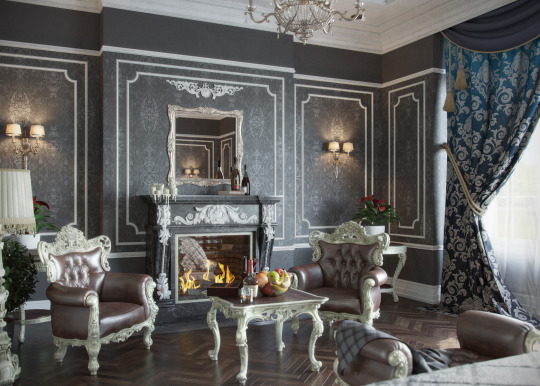
Their (and everyone else's, more or less) seating area and fireplace are directly to the right as you enter their room. They have two chairs as shown, a table, and a chaise that helps box that area in. The arm of the chaise faces the door. To the immediate left of the door is their wardrobe, and nestled between it and some bookshelves is their desk.
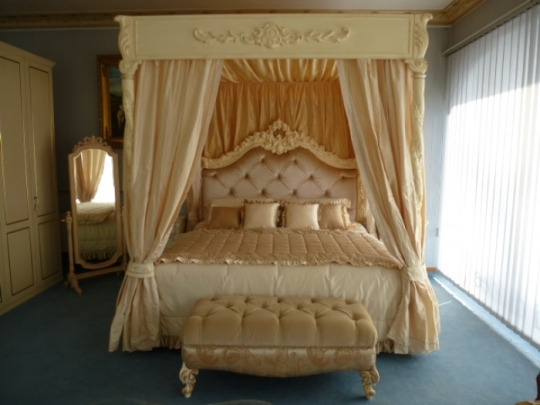
Their bed is canopied similarly to this one, and on the far wall across from the desk. To the right of it is the en-suite bathroom, and to the left are the doors to the balcony. Their room is done in dark burgundy and black, with touches of dark wood.
Everyone has an en-suite bathroom as well. Speaking of those...
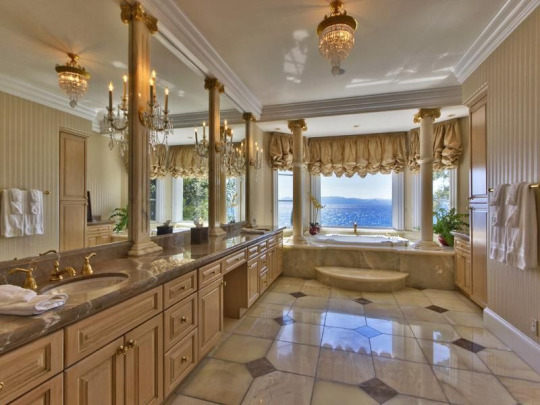
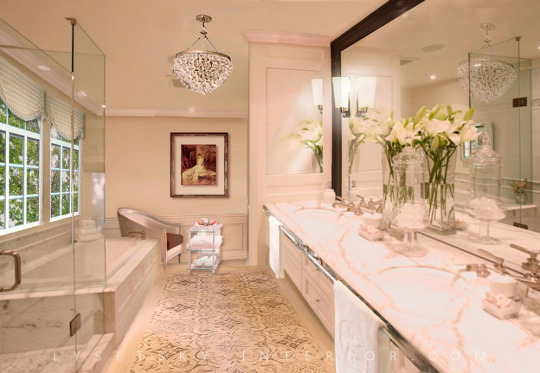
They don't have windows, but the full mirror is standard. The showers have frosted glass, and the tubs are claw-footed, not built-in. They're just as fancy as the rest of the castle is.
All of them still have the framing and paneling seen throughout the rest of the castle, as well as light fixtures and detailing. Colors, furniture, and the style of their beds are largely up to them.
Their room orders are largely:
Nightmare, at the head of the hall
[An empty garden-facing room] [Hallway] [Killer]
[Ren] [Hallway] [Axe]
[Empty garden-facing room] [Hallway] [Empty]
[Cross] [Hallway] [Empty]
[Baggs] [Hallway] [Chara, when he's here]
[Dust] [Hallway] [Empty]
[Empty][Hallway][Empty]
(Hopefully this more or less conveys the layout without actually drawing it, lmao.)
The hall turns left into the wing from a long hallway lined with windows on the garden-facing side. Everyone is on the second story.
29 notes
·
View notes
Text
10 Fresh Interior Design Ideas to Transform Your Home
Are you tired of looking at the same old décor in your home? It's time for a change! Here are 10 fresh interior design ideas to help you transform your space into a stylish and functional haven.
Add an accent wall A bold, colorful accent wall can add visual interest to a room and give it a fresh, updated look. Consider using a vibrant paint color or a statement wallpaper to make a statement.

Incorporate plants Bring some life into your home with plants. Not only do they add a touch of greenery, but they can also purify the air and improve your mood. Consider placing potted plants on tables, hanging plants from the ceiling, or using plants as a room divider.
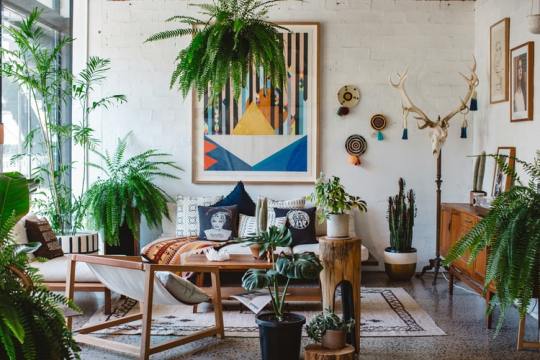
Update your lighting Lighting can have a big impact on the mood and atmosphere of a room. Consider replacing old light fixtures with newer, more stylish options or adding additional lighting sources, such as table lamps or floor lamps.
Mix and match patterns Don't be afraid to mix and match patterns in your home. A mix of prints and textures can add depth and interest to a space. Just be sure to choose patterns in similar color palettes to avoid a cluttered look.
Add a gallery wall A gallery wall is a great way to add personality to a room and showcase your art collection. Mix and match frames and artwork to create a cohesive, yet eclectic look.

Use patterned rugs Rugs are a great way to add color and pattern to a room. Consider using a bold, patterned rug as the focal point of the room, or layering smaller patterned rugs on top of a solid one for added texture.
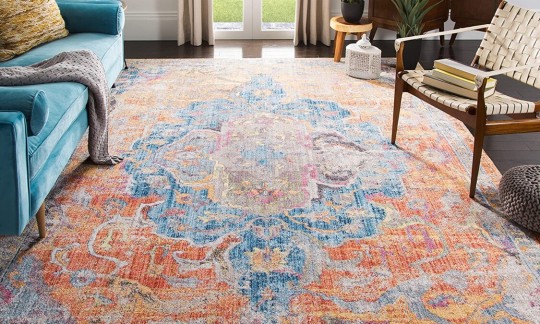
Invest in a statement piece A statement piece, such as a bold piece of furniture or a large piece of artwork, can add visual interest and make a big impact in a room. Consider choosing a piece that reflects your personal style and that you'll love for years to come.
Play with texture Texture adds depth and interest to a room. Consider using textured fabrics, such as velvet or wool, on furniture and accessories, or adding texture with baskets, rugs, and other home décor items.
Add pops of color A few pops of color can make a big impact in a room. Consider adding colorful throw pillows, artwork, or small accessories to add a splash of color.
Mix and match furniture styles Don't be afraid to mix and match furniture styles in your home. Mixing modern and traditional pieces can add depth and character to a space. Just be sure to choose pieces that share a similar color palette to create a cohesive look.
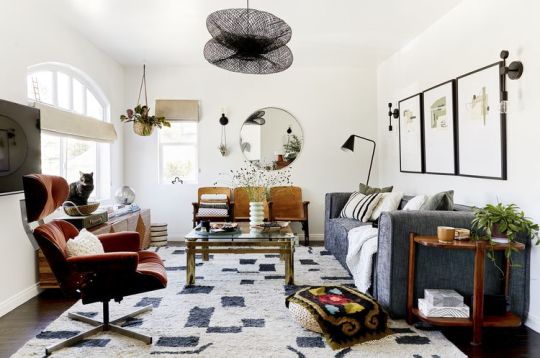
We hope these interior design ideas have inspired you to update your home. Remember, it's all about creating a space that reflects your personal style and makes you feel happy and comfortable. Don't be afraid to take risks and have fun with it!
#Interior Design Ideas#design ideas#design ideas blog#interior decorating#home decoration#decoration ideas#home design#decoration#living room decor#living room#design#transform your home#fresh interior design ideas#gallery wall#accent wall
79 notes
·
View notes
Text
Room design post! Just putting this here because I’m not great at interior design but I’m really trying. Would love feedback :)!
I have a funny (weird. bad) relationship with my house. Lots of reasons for this, no reason to get into it. Just believe me when I say certain vibes require cleansing and I’m not really a sage-burning guy. Mostly because I think it smells, well, ass. Sorry.
More below!
So. I’m diving into a redesign and shooting for a romantic maximalism situation that relies heavily on chinoiserie/chinoiserie adjacent patterns. My room is currently very non-designed. White walls. A few furniture pieces I like. Very little else. I want to transform it into something that feels totally new to me. A reset button, sort of. I’m not rich and I love craigslist so I’m hoping to build my room up second-hand.
Here’s what I’m thinking. My inspiration- only I will incorporate more modern things, and I don’t have 13 foot ceilings.
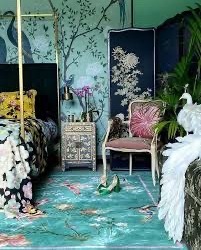
The plan:
1. Color matching the rug I got with the walls- I won’t wallpaper, I’ll use paint. The rug is tealish, like the one above! It was 9x13 and only $60!
2. A red vinyl bedframe I also found on Craigslist! $150. A bit rich for my blood, but I want to be bold. I want to commit. Half-assing it will guarantee the mark will be missed. (Pic is not my house).

3. One of these duvets and sheets. I don’t buy fancy bedding so figuring this out is gonna be a whole thing.


4. Then, I have this cool vintage bubble lamp. It’s yellow glass. That’ll go somewhere. I’ll post a pic of that later.
Then, there are these lamps. I think they’re so fun! But would they be practical, with like, dust? And cats?? Probably not. But I love pink and want to incorporate a little bit of it somewhere, somehow.

5. I need some dark things. Some negative space. No idea what. Not including a picture. Maybe some dark pillow cases? Maybe dark furniture? I have dark wood things, like a bookcase and a waterfall dresser. But is that dramatic enough?
6. I have some gold curtains in a different room. I’ll probably swap those out.
7. A lady is selling these. Four of them! So maybe I’ll get them, too.

8. I still need a few modern touches. Like, acrylic shelving or a chair, maybe, and some art prints that are fully modern. And few pure, solid colored bits and bobs. I was thinking a porcelain bust, maybe?
Also, just for fun, here’s another room I love that is serving as inspiration.

Idk. Do you have opinions on this? Ideas? Art you like that I should buy? I love you. thank you for reading.
8 notes
·
View notes
Text
Transform Your Space: Top Home Decor Trends for 2024 best color combinations for bedroom walls
Best color combinations for bedroom walls as we step into 2024, domestic decor continues to adapt, reflecting a mix of undying elegance and progressive functionality. This yr’s developments exhibit a deep appreciation for craftsmanship, sustainability, and personal expression. Here’s a comprehensive guide to the key domestic decor developments of 2024, imparting insights on how to refresh and increase your dwelling areas.

Sustainable Materials and Eco-Friendly Design
Modern farmhouse home decor ideas sustainability remains at the leading edge of domestic decor in 2024. Homeowners are an increasing number of looking for substances and designs that lessen environmental impact. Expect to look a rise inside the use of reclaimed timber, recycled metals, and natural fibers. Furniture made from sustainable assets, consisting of bamboo or reclaimed wood, is gaining reputation. These materials not most effective provide a completely unique aesthetic however also contribute to a more eco-aware life-style.

Eco-pleasant layout extends to decor items as nicely. Look for textiles crafted from natural cotton, hemp, and linen. Recycled glass and ceramics are making waves within the realm of home add-ons, imparting each fashion and a story of environmental stewardship. As greater human beings end up privy to their ecological footprint, the call for for sustainable and ethically sourced domestic decor is predicted to upward push.
Biophilic Design: Bringing the Outdoors In
Biophilic design, the practice of connecting interiors with nature, is still a distinguished fashion in 2024. This approach focuses on incorporating natural factors into domestic decor to beautify nicely-being and create a relaxing environment. Expect to peer an growth in indoor plant life, herbal mild optimization, and the usage of organic shapes and substances.
Incorporating indoor plants is extra than just a trend—it’s a lifestyle choice. Popular houseplants for 2024 encompass the Monstera, Fiddle Leaf Fig, and Snake Plant, each known for his or her air-purifying qualities and hanging appearance. Green partitions and vertical gardens also are making a dash, providing lush, colourful focal factors inside residing areas.
Neutral Palettes with Bold Accents
Neutral color palettes stay a staple, but 2024 introduces a sparkling take via combining them with bold, assertion-making accents. Expect to look heat taupes, creamy whites, and soft grays forming the base of interiors, complemented via colourful colorings like emerald green, deep military, and wealthy burgundy. These formidable accents can be delivered through add-ons including throw pillows, rugs, or art portions, taking into consideration clean updates and personalization.
Textured neutrals are also trending, with substances like bouclé, linen, and tender wool adding intensity and hobby to monochromatic schemes. This approach provides a sophisticated backdrop for dynamic accessory pieces, developing a balanced and visually attractive surroundings.
Vintage and Retro Revival
The allure of antique and unfashionable design is experiencing a resurgence in 2024. Mid-century modern fixtures, art deco accents, and nostalgic styles are making a return. This fashion celebrates the appeal and craftsmanship of past eras at the same time as integrating them into present day settings.
Vintage-inspired portions, inclusive of curved sofas, geometric rugs, and vintage lights, are being reimagined with a contemporary twist. Thrifted finds and vintage markets are popular resources for particular decor objects that upload man or woman and records to homes. Combining antique portions with contemporary factors creates a curated appearance that feels both undying and clean.
Smart Home Integration
As era keeps to enhance, smart domestic integration turns into increasingly seamless. In 2024, clever home devices are designed to mixture resultseasily with domestic decor. Sleek, unobtrusive designs make certain that era enhances in place of detracts from the cultured of a area.
Smart lighting fixtures systems, voice-managed assistants, and automatic climate control are only a few examples of the way technology is being included into domestic decor. These systems are not simplest functional however also customizable, permitting owners to create personalised environments that adapt to their desires and choices.
Artisanal Craftsmanship
Handmade and artisanal objects are highly prized in 2024. There is a developing appreciation for craftsmanship and the precise traits of handmade items. Artisanal decor, from handwoven rugs to handcrafted ceramics, provides a non-public touch and helps local artisans.
This trend emphasizes the value of talent and way of life, with a focal point on excellent and individuality. Handmade pieces often function imperfections that add to their appeal, making every object a one-of-a-kind addition to your private home. Incorporating artisanal decor fosters a feel of authenticity and connection to the creative technique in the back of every piece.
Flexible and Multi-Functional Spaces
The concept of flexible and multi-useful areas is gaining momentum in 2024. As houses turn out to be increasingly more adaptable to various desires, the point of interest shifts toward furnishings and layouts that provide versatility. Modular furniture, foldable portions, and convertible rooms are key elements on this trend.
For instance, a visitor room can double as a domestic workplace, way to a fold-down desk or a Murphy bed. Modular sofas permit for reconfiguration depending at the event, and multipurpose garage solutions help preserve areas organized and litter-free. This technique maximizes capability without compromising on style, catering to the dynamic needs of modern-day living.
Maximalist Accents
While minimalism continues to be famous, there is a developing trend toward maximalist decor in 2024. This fashion embraces abundance and eclecticism, encouraging the mixture of bold patterns, vibrant colorations, and diverse textures. Maximalist decor is all approximately expressing personality and creativity through a curated collection of items.
Think layered rugs, statement wallpaper, and an array of decorative items. The key to a hit maximalism is stability; mix patterns and colors in a way that feels intentional as opposed to chaotic. This fashion allows for personal expression and creates areas which can be visually stimulating and uniquely reflective of their occupants.
Art Deco Revival
Art Deco is making a amazing comeback in 2024, with its expensive and sumptuous fashion being reinterpreted for modern interiors. Characterized by using geometric shapes, wealthy colorations, and elegant materials, Art Deco provides a hint of glamour to any area.
Incorporate Art Deco factors via declaration lighting fixtures, mirrored surfaces, and velvet fixtures. Metallic finishes like gold and brass, together with formidable patterns, contribute to the state-of-the-art charm of this style. Art Deco accents can remodel a room into a glamorous retreat, ideal for folks that admire a hint of vintage luxurious.
Personalized Spaces
Finally, 2024 emphasizes the significance of creating customized spaces that mirror character tastes and life. Customization is prime, with homeowners in search of methods to make their interiors uniquely their own. This fashion entails choosing decor that resonates for my part, whether or not through custom furnishings, bespoke artwork, or curated collections.
Eco-friendly home decoration personalized spaces are about extra than simply aesthetics—they're about developing environments that foster comfort and pleasure. Incorporating private mementos, significant paintings, and custom-designed factors ensures that each room seems like a true mirrored image of its population.
#Eco-friendly home decoration#Modern farmhouse home decor ideas#Best color combinations for bedroom walls
2 notes
·
View notes
Text
Irregular Shape Rug Modern Geometric Asymmetrical Contemporary Area Handmade Carpets
Welcome to Warmly Home!
Awesome Irregular Shape Rug!
Online Rug Store with Excellent Service!
New Design, New Trends, and New Ideas!
Interior Design Inspiration and Home Decor Items!
Enjoy your online shopping time!
Product: Irregular Shape Rug
Feature: Durable and Easy To Clean
Style: Creative Odd Shaped Design
Technique: Power Loom, Hand-Made Gun-Tufted
Construction: Machine-Made,…

View On WordPress
2 notes
·
View notes
Text
Urban Chic Loft Design Ideas

Modern loft interior with exposed brick, large windows, sectional sofa, and geometric rug.
Follow Ceramic City on Tumblr
Source: https://research-lighting.tumblr.com/post/747656496403382272/urban-chic-loft-design-ideas-follow
#modern#design#product design#home#decor#decoration#home decor#home design#interiors#interior design#living room#bedroom#kitchen#buildings#architecture#furniture#furniture design#industrial design#minimalism#minimal#living rooms#lighting design#lights#bathroom
6 notes
·
View notes
Text
Scandinavian Style House Plan
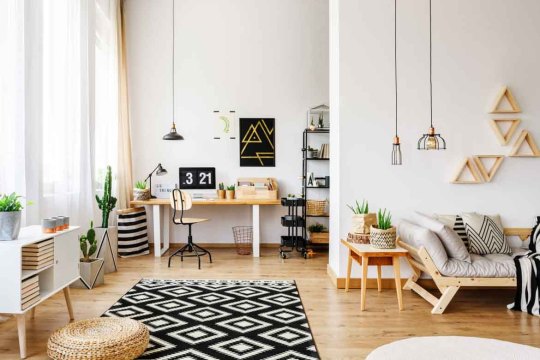
Modern Scandinavian house plans are flexible and adaptable to changing lifestyles. This allows homeowners to transform rooms based on their needs.
Simple and Minimalist Design Style
The style is simple and minimalist yet cozy and influenced by nature. It is often described as "lagom." It means a balance between function and beauty. Here are some ways to incorporate this design style in your home.
Scandinavian design embraces a variety of natural materials to add texture, warmth and a connection to nature. Wood slat walls, exposed beams, and light wooden furniture are common throughout the home. Embracing hygge, soft textiles like sheepskin area rugs and throw blankets are used in conjunction with modern straight lines to create cozy, functional spaces.

Large windows and skylights allow natural light to flood interior rooms, providing a healthy and bright living environment. Having a steeply pitched roof is also a must, as it helps to shed snow and other harsh weather elements. When buying a Scandinavian style house there are many things you need to pay attention to and think about.
Creating Scandinavian Exterior Lighting
Adding house numbers, mailboxes and unique exterior lighting can help to customize your Scandinavian style home. Decorative accents like doormats and planters can also bring the style together for a personal touch. When it comes to decorating, avoid using too many colors or patterns, as this can feel too busy. Instead, choose a few small pieces of artwork to draw the eye and enhance the clean lines of the room.
Large windows are a staple of Scandinavian house plans. They help to bring in natural light while preserving privacy and warmth. Often, these windows are double or triple-glazed to keep out the cold and save energy.

With their neutral color palette and large windows, Scandinavian home plans offer a timeless look that appeals to many homeowners. However, this style can also be updated with contemporary elements like an open floor plan, technology integration, and flexible living spaces that adapt to changing lifestyles.
Scandinavian-Style Home Design
The defining traits of a Scandinavian-style home are its simplicity, functionality, and connection to nature. Its timeless design has captured the attention of architects and homeowners worldwide. Learn more about the history and current trends of this architectural style to find out how you can incorporate Scandinavian-inspired elements into your home. Then, discover our collection of Scandinavian-style house plans to find the perfect fit for you.
Modern Scandinavian design emerged in the 1950s alongside a wave of modernist movements that swept across Europe and North America. The style focuses on clean lines, functional furniture, and a neutral color palette. It also encourages natural light, open spaces, and a cozy feel.

In the bedroom, opt for a low-profile platform bed with an upholstered frame that aligns with Scandinavian aesthetics. Keep your duvet covered in a white or grey linen for a sleek look. Add a few minimalist nightstands and a wooden dresser to keep the space clutter-free and in line with the design's principles. The simplest idea for us to get a Scandinavian house is through the property sales site property.thegardengranny.com.
2 notes
·
View notes
Note
what is your favorite and least favorite home decor style????
Thank you for the ask!! These are so much fun for me! The original post is here =)
I did some googling for this so I could sort of technically correct. I say that like it's some kind of sacrifice, but I love googling things. I love knowin' stuff.
My least favorite style is minimalism. I'm taking minimalism into the alley behind the bar and fist fighting. I don't want to live in a white cube. Fuck minimalism. I also don't love the ranch house style, unless it's a legit ranch house. Why does your McMansion in the suburbs need a barn door and, like, a cowhide rug? I hate it and I hate the suburbs. (No hate to anyone who lives in a suburb, they just have negative environmental impacts. Also, Lyme Disease.)
There are some elements of art deco and mid-century modern that I really like, but I don't necessarily know what I have a definable favorite. When you google about interior design it all feels very sterile and unlived, but if I really, really had to give an answer and go with it, I might say contemporary, which feels a little like a cop out, but that's kind of what I'm going for. I know I said I'm about to start apartment hunting, but I have no idea what I actually what that space to look like at this point. It depends on how much I hate myself after working harvest and how much motivation that allows me.
#asks#betweenthings talks#betweenthings2#is it obvious I know very little about interior design?#is it also obvious that I've only ever lived in my parents' house and campus housing?#I think it might be
1 note
·
View note
Text
youtube
Introduction
Hi, and welcome to Venusstadt. I’m Jiana, and this is the final part of a two-part series on globalism and its aesthetics throughout the 90s. Today, I’m discussing 90s globalist conceptions of the future, the most popular of which is definitely Y2K.
In the first part—which I HIGHLY recommend watching—I explained what globalism is and how the interconnectedness from new tech AND the sense of being at the ‘end of history’ led to the emergence of various aesthetics as people looked back at the history of humanity and looked forward to a new age.
During my analysis of these aesthetics I also spoke about cultural appropriation and exchange, as well as how white supremacists appropriated neoclassical aesthetics to be racist towards everyone else and establish themselves as “superior,” “civilized,” or “modern,” which is the perfect segue for this adjacent context I’m about to give.
Minimalism: A Brief Interlude
So, 90s minimalism!
Minimalism was not influenced by globalism by any discernible means, save for those minimalisms that were imported predominantly from Japanese culture and based on Buddhism as a part of the New Age movement and how it trickled into general 90s design philosophies.
Elly Parson of Refinery29 mentions that in the 90s, minimalism was more prominent in high-design spaces like rich people’s homes, hotels, storefronts, and luxury fashion rather than the interiors and wardrobes of the average person (Parson). Still, it’s significant, because when we think of minimalism, we harken back to the 90s since it was a response to maximalism in the 80s as I mentioned at the beginning of the last part.
Minimalism has come back around in fashion and design more recently, which has prompted a look at its origins. So I’m sure a lot of you by now know about Adolf Loos, a prominent modernist architect who is also associated with minimalism, who saw excess ornamentation as “savagery” and saw European modernism as “the ultimate answer to all aesthetic problems” (Chayka). Naturally, because of this, any time people give a cultural or sociological critique of minimalism, his name is involved.
Now, associating any ornamentation with the Other is racist, as are the loaded terms “savage” and “degenerate,” which he uses in his infamous essay Ornamentation and Crime (Loos 20).
In his essay, he also distinguishes art like rugs from things like buildings and furniture, which he views as needing to be firmly utilitarian (Loos 24). To him, any decoration of utilitarian things was a sign of cultural devolution and savagery (20). He advocated for more minimal aesthetics in order to reach a timeless look that could survive as civilization marched on (22).
Much of the language used is eugenics-speak, and goes back to the notion of social degradation that was VERY popular in the early 20th century. This was the idea that non-white people and poor white people could spread their “defectiveness” and therefore needed to be kept from mixing their genes with middle- and upper-class Western white folks for the good of civilization (Eugenics Archive Canada, “Degeneracy”).
From this we also get the concept of cultural degradation, which is basically the same thing, except that it hyper focused on the idea that non-Western and lower-class culture could lead to “lowered standards of education and failures of taste-inculcating institutions,” and, again, the demise of Western culture (Wampole).
So, to further summarize, there was a fear among Western white society that the art, music, and aesthetics of people of color and the poor, aka the cultures of the “Other,” could lead to societal and cultural regression, and thus annihilate Western civilization. And these fears were used to create laws and initiatives to both murder the said “Other” and eradicate their cultures—think, for instance, forced sterilization, the American Indian boarding schools, Henry Ford’s anti-Jazz initiatives, Tom Buchanan’s speech in the Great Gatsby, the Nazis entire existence, every US culture war spat since like, the 60s—you get the picture.
Now, none of this is to say that people are weird eugenicists for liking modernist or minimalist aesthetics. I’m just using this to highlight rhetorics of modernity. As we saw prior, anything ornate or “other” is of the past, while what is “Western” is viewed as progressive, timeless, and more utilitarian.
“Progressive” and “timeless” are the keywords as I move into explaining the next set of aesthetics, which I’m calling the aesthetics of eternity, because that sounds really cool.
Eternity & Anxiety
So in the 90s, the rapidly approaching year 2000 was a big deal, for obvious reasons. A new millennium was on the horizon, which only happens like, once every a thousand years.
Plus it was the end of a technologically accelerated century. The mid-1900s started with inventions like the radio, the car, and the airplane; and by the early- to mid-1990s, people had gotten used to personal computers a la Apple and Microsoft, home video systems, and video game consoles like Atari and Gameboy, on top of previous inventions like photography and film, space rockets, and much, much more (Woollaston).
With all that in mind, people were looking forward to the future, while also being slightly afraid of it, as we see with the Y2K crisis (Wade). This excitement and fear appeared in the future-inspired aesthetics.
Like the global village aesthetics, this section is also split up in two: minimalist eternities and global anxieties.
I use the term minimalist “eternities” for this first portion to bring back the prevalent idea that the less ornamentation or cultural markers there were in design, the more “timeless” it would be.
This is observable in the industrial and sartorial design of a lot of Y2K or the Y2K-esque, like Cyber Corporate or Gen-X Soft Club. These designs are “clean.” They cannot be tied to a specific culture or time-period; it’s like they exist in this vacuous, liminal space. With Cyber Corporate specifically, CARI co-founder Evan Collins notes that it “seemed to be the go-to style to appear contemporary, especially with companies in industries associated with booming fields of the era” (Collins, “Cyber/Gen-X Corporate). And what’s most striking about these images is that they were contemporary and futuristic back then and STILL feel exciting and futuristic now, because of that minimalism.
As you can see, this is intentionally antithetical to the globalist aesthetics, which, because of their multicultural influence, were considered to be of the past.
But obviously the multicultural influence did not disappear altogether. In fact, it in some ways meshed with the futuristic aesthetics. This is especially true when it comes to East Asian cultures, specifically that of Japan.
So, like I said in part one, Western upper- and upper-middle folks were living large in the 1980s (White).
But Japan was also experiencing an economic upswing thanks to their export of tech and cars (White). And, of course, any time a non-Western country starts to have a bit of success, the West gets a bit uneasy. In 1985, Thomas White wrote in the New York Times:
“40 years after the end of World War II, the Japanese are on the move again in one of history’s most brilliant commercial offensives, as they go about dismantling American industry” (White).
Basically, White feared that American economic dominance would be thwarted by Japan due to how much America was importing as opposed to exporting, as well as the rise of companies like Toyota, Sony, Hitachi, Honda, and others (White). These imports especially spelled trouble for the American car industry, which was utterly gutted as people stopped preferring American cars (White).
There was also a fear that Japan’s steady rise would uplift other Asian markets (White). As White states: “Behind Japan (‘the big dragon’ some call it) march the ‘four little dragons’ (Korea, Hong Kong, Taiwan, Singapore) following in its path. And behind loom China and India, desperate as they are to raise their standards of living—at the expense of American standards, if necessary” (White).
The invocation of the dragon is unmistakably Orientalist of course, which brings us to techno-orientalism. With the rise of globalization and interconnectedness that came from it and the aforementioned “need for a new ideology to justify America’s hegemonic status at the end of the Cold War” (Harris) came this new breed of orientalism that was being leveled against Japan and other countries.
The term “techno-orientalism” was first coined by David Morley and Kevin Robins, a portmanteau of technology and Orientalism, which denotes the stereotypical lens by which the West often views the East (Harris). Unlike traditional (Said’s) Orientalism, which relies on stereotypes of the past, techno-orientalism relies on constructions of a future in which the East accomplishes supremacy through technological might (Harris) despite being non-Western and thus “of the past” and “degenerate”. As explained further:
“The techno- of techno-orientalism, then, comes to signal Orientalism’s relationship to economic globalization and to a form of temporal asymmetry: an Asian-ness characterized by the juxtaposition of cultural retrograde with technical hyper-advancement” (Harris).
Now any sort of perceived cultural dominance from a place that is non-Western, as we saw previously in the section about social and cultural degradation, always gives Western countries anxiety. For techno-orientalism, the level of this anxiety honestly depends on where you look, and sometimes it can’t really be described as anxiety but more of your run-of-the-mill cultural appropriation to seem hip or on-trend.
On the actual anxiety side, techno-orientalism is most associated with the cyberpunk genre, which features both technological advancement but is often set in a dystopian world. Now this genre obv. originated in the 80s and not the 90s like some of these other aesthetics, but it remained a prominent mainstay of the 90s and continued into the early 2000s.
For more specific film and storytelling examples of this, see the Japan Takes Over the World page on TV Tropes because I’d really be here all day if I went through all of them. Harris mentions multiple visual hallmarks of the genre, but in this case, these visuals are all unified by being a mix of Asian aesthetics and high-tech milieus. And I don’t believe this was incorporated into general industrial or architectural design, but it was a present in marketing and, to a certain degree, music.
2001: The Global Bubble Bursts
So, what happened to these aesthetics?
Well, like any trend, they faded away thanks to a change in the outside factors that brought them into the spotlight.
For one, in March 2000, the Dot-com bubble burst (Salvucci). This leads to large online companies (like Amazon) losing some of their values and causes smaller online companies to shut down, as well as a slight recession in the early 2000s (Salvucci). I don’t want to go into business and economic jargon so I won’t go too far into this, but think of the Dot-com bubble popping as the 2000s equivalent of the cryptocurrency crash we just had with the collapse of Terra-Luna and FTX. This puts a damper on the whole tech innovation schtick that people had going in the 1990s.
Then the attack on the World Trade Center occurs, which, on top of mounting criticism against globalism in the 90s thanks to the loss of industrial jobs in the U.S., absolutely killed the utopian globalist dream (Schwartz).
These events burst the 90s “cultural bubble” (Williams), and lead many to look back on the decade as frivolous and void of American cultural values.
Writing for the New York Times in November 2001, John Schwartz declared that:
“… the country is experiencing a shift away from the libertarian, individualistic values that were expressed in the celebration of the New Economy and toward more old-fashioned values in the wake of the terrorist attacks” (Schwartz).
This was a direct dig at Gen X, since the 1990s was powered by Gen X’s progressive, entrepreneurial spirits (Gross). We know these individualist values didn’t disappear with 9/11—after all, America was founded on such individualist values, and they would power the rampant Islamophobic sentiment in the wake of the attacks. The ‘libertarian, individualist values’ in question were that, as we know from the original 1990s article that defined them, Gen X were less loyal to specific corporations than they were to the idea that they could job hop and earn more money to support themselves.
Also, not that I’m some tech warrior or anything, but there’s a lot of reference in Schwartz’ article to the leaders of the Dot-com boom being ‘geeks’ and ‘whiz kids.’ Immature high school imagery, of course, but it also alludes to the idea that instead of these geeks winning at capitalism it should be the well-rounded, all-American kids—which, like everything in this video, is a coded concept.
Throughout the 90s, there was a growing nationalist movement in response to globalism, and the people involved were blaming immigration and undocumented immigrants for lost factory jobs that were being outsourced to other countries (Chatzky, McBride, and Sergie). This, along with things like people of color and gay people having rights, was a major factor in the 90s culture wars, the rise in paleo-conservatism, and a desire to “reclaim the United States” that would lead to events like Ruby Ridge and Waco, and then Oklahoma City, and then Columbine, and all the issues we still have today.
After Sept. 11, this nationalist sentiment became more mainstream thanks to the War on Terror. Accordingly, the multicultural and techno-futurist aesthetics of the 90s faded away.
There’s a return of preppy style, which had not been popular since the 1980s—again, a conservative period. This time around the prep style is embodied by stores like Aeropostale and Abercrombie and Fitch, the latter of which relied on images of thin, conventionally attractive models, and all-American (read: white) marketing for its desirability factor (Klayman).
We do see more traditional Orientalist imagery peak in the mid-2000s and fade by the 2010s (Collins, “Millennium Orientalism – Eastern Exoticism”). I don’t know what to make of this: judging by my previous multicultural aesthetic analysis I would call it either some appropriative attempt at peace and anti-war sentiment or at worst super insensitive given that Middle Eastern, South Asian, and Southeast Asian people were being conflated with one another, hate crimed, and labeled terrorists while their cultural aesthetics were being used for funsies. We’d also see some techno-futurist themes in Frutiger Aero (though the techno part was more played down) in line with tech innovations like social media and the launch of the 1st generation iPhone in 2007, but this seems like a nostalgic late Gen-X/Millennial grasp at Y2K.
2020: A Global Re-emergence?
So obviously Y2K is back and has been back for years, though in its current iteration that term refers to a mix of original Y2K, McBling, and some late 2000s stuff we don’t even have a name for yet. The most obvious guess for why these came back is because of the ubiquity of social media websites since they’ve taken over the internet (and because they’ve allowed for such archiving that re-introduced everyone to such aesthetics), especially because of the pandemic.
Evan Collins says that for Global Village Coffeehouse at least, it never came back and never was remembered as part of the general 90s aesthetic. I too thought these global aesthetics would be dead and gone forever since we’re more aware of cultural appropriation nowadays, but someone on TikTok pointed out that now that the U.S. is looking a little not global superpower-ish and other countries and fashion capitals are emerging, there’s a rush of multiculturalism again, at least in the luxury space. So, that could be exciting.
With both aesthetics, I feel like we’re far more skeptical and more culturally aware. There’s not an utter faith in tech or a blithe willingness to borrow from other cultures like there was in the 90s. And though people criticize Gen Z for biting from past aesthetics (as they did with Gen X), I think this is just a side effect of all these cultural materials from the past being available thanks to the Internet and things like the Wayback Machine. As with Gen X, our generation’s main cultural marker is that the interconnectivity and speed we have at our fingertips enables us to run through past aesthetics almost as quickly as we find out about them—but that’s a topic for a future video!
Conclusion
And that’s all I have for this video. I realized towards the end that this was just a big excuse to talk about globalism, but, again understanding culture is important to understanding design aesthetics, so I hope you all learned something from this video that could help you in that respect.
As always, if you enjoyed this video, give it a like and maybe even click the subscribe button below for more. My channel is still new and I’m testing things out, so any feedback would be appreciated. I can also be found on Twitter and Tumblr. Thanks for watching!
Sources
Chatzky, Andrew, James McBride, and Mohammed Aly Sergie. “NAFTA and the USMCA: Weighing the Impact of North American Trade.” Council on Foreign Relations, 1 July 2020, https://www.cfr.org/backgrounder/naftas-economic-impact. Accessed 7 April 2023.
Chayka, Kyle. “The North American Maximalism of Gigi Hadid’s and Drake’s Home Design.” The New Yorker, 5 Aug. 2020, https://www.newyorker.com/culture/dept-of-design/the-north-american-maximalism-of-gigi-hadid-and-drakes-home-design. Accessed 6 April 2023.
Collins, Evan. “Cyber/Gen-X Corporate.” Are.na, https://www.are.na/evan-collins-1522646491/cyber-gen-x-corporate. Accessed 7 April 2023.
Collins, Evan. “Millennium Orientalism – Eastern Exoticism.” Are.na, https://www.are.na/evan-collins-1522646491/millennium-orientalism-eastern-exoticism. Accessed 7 April 2023.
Eugenics Archive Canada – Their website seems to be broken now, but here’s a link. http://eugenicsarchive.ca/
Gross, David M, and Sophronia Scott. “Proceeding With Caution.” Time, 16 July 1990, https://content.time.com/time/subscriber/article/0,33009,970634-9,00.html. Accessed 7 April 2023.
Harris, Elif. “Orientalism & Technology: A Primer on the Techno-Orientalism Debate.” Elif Notes, 15 March 2023, https://elifnotes.com/techno-orientalism/. Accessed 14 April 2023.
Klayman, Alison, creator. White Hot: The Rise and Fall of Abercrombie & Fitch. Second Nature, Aliklay Productions, Cinetic Media, and All3Media America, 2022.
Loos, Adolf. “Adolf Loos: Ornamentation and Crime.” George Washington University, https://www2.gwu.edu/~art/Temporary_SL/177/pdfs/Loos.pdf. Accessd 6 April 2023.
Parsons, Elly. “‘90s Interiors Were Eclectic, Fun, & Free. Now They’re Back.” Refinery29, 23 Sept. 2021, https://www.refinery29.com/en-gb/90s-interiors-homeware-trend. Accessed 6 April 2023.
Salvucci, Jeremy. “What was the Dot-Com Bubble and Why Did It Burst?” The Street, 12 Jan. 2023, https://www.thestreet.com/dictionary/d/dot-com-bubble-and-burst. Accessed 7 April 2023.
Wade, Grace. “The Y2K Movement: Its History and Resurgence.” Stitch Fashion, 19 June 2018, https://www.stitchfashion.com/home//the-y2k-movement-its-history-and-resurgence. Accessed 7 April 2023.
Wampole, Christy. “Can Culture Degenerate?” Aeon, 5 Aug. 2021, https://aeon.co/essays/the-idea-of-cultural-degeneration-has-an-unsavoury-pedigree. Accessed 6 April 2023.
White, Thomas. “The Danger from Japan.” The New York Times Magazine, 28 July 1985, https://www.nytimes.com/1985/07/28/magazine/the-danger-from-japan.html. Accessed 14 April 2023.
Williams, Alex. “2001: When the Internet Was, Um, Over?” New York Times, 8 Oct. 2008, https://www.nytimes.com/2018/10/08/style/dot-com-crash-of-2000.html. Accessed 7 April 2023.
Woollaston, Victoria. “The Best 1980s Gadgets that Defined a Decade.” Pocket-Lint, 20 Feb. 2023, https://www.pocket-lint.com/gadgets/news/147958-12-best-1980s-gadgets-that-defined-a-decade/. Accessed 9 May 2023.
8 notes
·
View notes
Text
Beautiful Space Interior Designing Ideas
Beautiful home interior designing ideas can be achieved by using muted colors and textures, using natural materials. Many homeowners are choosing to focus on eco-friendly practices and turning to sustainable construction methods in order to achieve a home that is also comfortable and functional. When it comes to interior design, there are countless ways to bring traditional beauty and modern technology together seamlessly. Finding inspiration for home decor is no longer a challenge. how do you pick what’s perfect for your home? Well, that’s for your personal taste to decide. Some like it minimal, some feel at home in vibrant spaces. Some keep it old school and some have a taste in ultra-modern interiors. If you want to stay updated on how to keep your interiors spiced up and inspirational at all times, you need to check these out!
Hang Interesting Pendant Lights: Lighting can make or break even the best interior design. If you want to impress guests with thrilling home interior design, be sure to get the lighting right. Pendant lamps are the best choice of lighting for a modern home interior. But when it comes to pendant lights, make sure you choose something that has an extraordinary, unusual design – one that calls attention and can trigger visual focus upward.
Consider colors and fabrics: Start to hone in on the colors you want to use – for the painted walls or wallpaper, furniture, blinds and curtains. The third color could be a highlight for cushions, lampshades, bed quilts and accessories such as a tablecloth or even a painting.
Size up the furniture: Decide on the furniture you want in your room. Think about scale, in a large room you need a big sofa and footstool. Most designers recommend that even small rooms should have one large statement piece, even if it is a headboard in a bedroom. A balance of large and small pieces will create an appealing living space. Keep your furniture simple and natural looking. This will help to unify the whole room and create an atmosphere of calmness and serenity.
Play with patterns: You don’t need to stick to one pattern in a room — you can mix two or three prints harmoniously without much effort. Pay attention to the scale of the patterns — smaller, busier prints look best on compact surfaces such as cushions or tertiary elements, such as a floor rug. Bold, large patterns usually work well on focal elements with white space around them.
Get plants: Whether you are looking to add a statement piece or just want to fill an empty corner or table, indoor plants add depth and character to any room. Plants can add much-needed color to some rooms or bring a touch of freshness into an industrial-style space. You can place plants in earthen pots, cups, mason jars or terrariums, depending on the look you want to create. Add lots of flowers, trees, bird feeders, etcetera to create a lush environment that invites visitors in . .. and makes them feel at home!

Use natural materials such as wood, stone, and clay. These materials have a certain warmth and uniqueness that will make your room feel like your own personal space.
Use bright colours sparingly but energetically to add some life to a dreary room. Opt for cheerful oranges and yellows instead of dull greens and blues, for instance.
Choose mood-setting wallpapers or carpets that perfectly match the colour scheme of the room and complement the natural features of the walls or flooring.
Space Creater is Best Interior Designing Company in Patna. To Know More details please feel free to contact us. Our website address is https://spacecreater.com/
Address: Office no 103, Laxmi Complex, beside central bank of india, boring road, Patna
Contact : 9939081333
12 notes
·
View notes
Text
13 Poker Flats - 2
So, here’s the rest of Amy/Yukee’s house.


I did change the floor and wall finishes here. Where you see all that purple, I think EA did it with royal blue - which gave me the idea for this room. So, the basic bathroom stuff was done by EA, only in blue. I upgraded her interior doors and changed the tiles on the floor and that printed area on the tile walls. Plus, I gave her a rug, that towel thingie from one of the stuff packs, and a hamper for her clothes. And some windows, which I may change.


In her kitchen I pretty much changed everything. EA went with a puke green and orangey color-scheme and had those base-game cabinets. So, even though Yukee is still fixated on purple, it’s not as nauseating as what was there. I did leave the laundry stuff as EA had it, since Yukee can’t afford to buy new. Plus, she likes it, because they match the green stripe in her plaid wallpaper.

And this is her lovely bedroom! I did change the railing for something more modern - EA had a white wrought iron one - And I gave her a new wallpaper, which is a gradient purple. (Hard to tell here).

And this is the deck off her bedroom. I did add some more windows here and gave her some deck lights. Plus, I added that drainpipe and somewhere, I added that electrical box.
Other than Sofia Carlton, Amy is the only sim I have ever played in Twinbrook. When I opened this town for the very first time, I chose her on a whim. I think it was her lovely wardrobe choices that caught my eye! Anyway, there was a weird sound, and she went outside to investigate it. While I was trying to figure out what the frack was going on, KABAM! She got squished by a meteor! Laughed my a** off. She’s the only one of my sims to ever get hit by one. A few have had a couple close calls, but only poor Amy got squished. But it put me off this town for a while.
8 notes
·
View notes